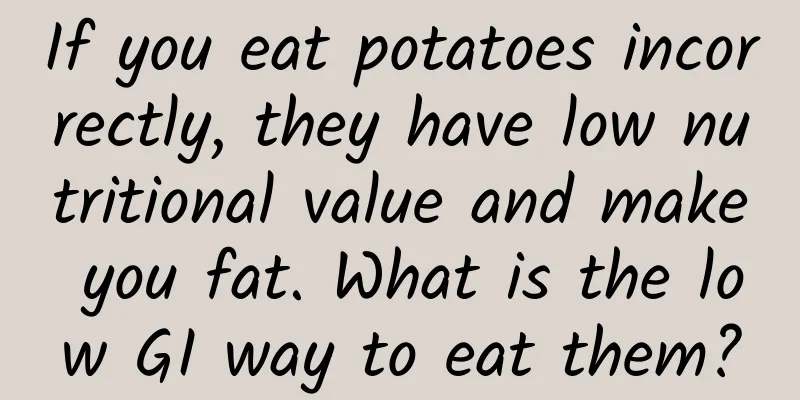If you eat potatoes incorrectly, they have low nutritional value and make you fat. What is the low GI way to eat them?

|
Potatoes are a very common food in our lives and can be eaten all year round. They are also called potatoes, sweet potatoes, and underground apples. Potatoes originated in the Andes Mountains in South America and then spread to more than 160 countries and regions, including our country. my country has a history of more than 500 years of potato cultivation and has now become the largest producer and consumer of potatoes. The reason why potatoes are loved by Chinese people is not only because they are delicious, but also because they can be cooked in many ways, such as steaming potatoes, boiling potatoes, stir-frying potatoes, mashing potatoes, frying French fries or potato chips, etc. Although there are many ways to cook potatoes, different ways will have different effects on the nutritional value of potatoes. What are the specific differences and how to eat them better? This article will talk about potatoes. What nutrients do potatoes have? Potatoes belong to the tuber family. One of the characteristics of tuber foods is that they are rich in carbohydrates. The carbohydrate content of potatoes is 17.8 g/100 g[1], and the total dietary fiber content is 2.5 g/100 g[2], of which the insoluble dietary fiber content is 1.1 g/100 g. Insoluble dietary fiber can promote gastrointestinal motility and prevent constipation, while soluble dietary fiber can lower blood lipid and cholesterol levels and prevent chronic diseases. In addition, the dietary fiber in potatoes has a fine texture and can be eaten even by people with gastrointestinal discomfort. The protein content of potatoes is 2.6 grams per 100 grams. Although the content is not high, it is a high-quality protein. Essential amino acids account for 47.9% of the total amino acid content. [3] It is rich in lysine, which can just make up for the shortcomings of staple foods such as rice and wheat. Eating potatoes with rice, wheat and other foods in a meal can improve the overall protein utilization rate. The vitamin C content of potatoes is relatively high among cereals and tubers, at 14 mg/100 g.[1] This content is higher than that of apples, nearly five times that of apples. The vitamin C content of different potato varieties varies, and cooking can also affect the vitamin C content. In addition, potatoes are high in potassium, at 347 mg/100 g, which is 1.4 times that of bananas, which are considered to be rich in potassium. This is very friendly for people who need to control blood pressure. Since potatoes are so nutritious, what effects do different cooking methods have on the nutritional content of potatoes? Effects of different cooking methods on the nutritional content of potatoes The most common ways to cook potatoes are steaming, boiling, stir-frying, and deep-frying. Occasionally, people also use microwave ovens to cook potatoes. What effects do different cooking methods have on the main nutrients in potatoes? [3] Steaming: Steaming potatoes is the most common method for northerners. It is quick and easy. It causes almost no loss of minerals and vitamins, and can maximize the retention of nutrients in potatoes. Steaming also destroys plant wall cells, releasing flavonoids and anthocyanins. Polyphenols are heat-resistant, so the total phenol content of steamed potatoes will increase. Boiling: Boiling potatoes will cause the loss of water-soluble vitamins, with a loss of 77~88% of vitamins. It will also cause a decrease in the carotenoid content in potatoes, but the effect on phenolic substances is relatively small. Stir-fry: Stir-fried shredded potatoes is a very common dish in life. During the process of frying shredded potatoes, the vitamin C content shows a downward trend, the vitamin loss rate is 30~40%, and the carotenoid loss rate is less than 25%. If you want to retain more nutrients when stir-frying shredded potatoes, it is recommended to use high heat and quick stir-fry to shorten the cooking time. It is best to use a stainless steel pot or non-stick pot, which can better reduce the loss of vitamins compared to traditional iron pots. Deep frying: Surprisingly, deep frying does not cause much loss of vitamin C in potatoes, with a loss rate of only 55-79%, which is less than the loss caused by steaming. This may be because the hot oil only contacts the surface of the potatoes, leaving the vitamin C inside relatively intact. However, frying is a high-temperature cooking process, and acrylamide, a Class 2A carcinogen, is easily produced during the cooking process. The protein in potatoes is easily converted into heterocyclic amines, a carcinogen, and the fat content is high, which can have adverse effects on health. It is recommended to eat less. Microwave: It is relatively rare to use microwave ovens to cook potatoes. Most people are not used to using microwave ovens to cook food. In fact, it is relatively healthy to cook potatoes in microwave ovens. Microwaves can degrade polyphenol oxidase in potatoes and protect anthocyanins and phenolic substances. Studies have shown that microwave treatment of potatoes can increase the content and antioxidant activity of free polyphenols, bound polyphenols, and chlorogenic acid in purple potato strains. The loss rate of vitamins is also the lowest, only 21-33%. Microwaves can minimize the nutritional loss of potatoes. Effects of different cooking methods on the GI value of potatoes Although potatoes are nutritious, different cooking methods will affect the GI value of potatoes. The GI value is the glycemic index of food, which is an effective indicator to measure the blood sugar response caused by food after a meal. The lower the value, the better it is for blood sugar control. The GI values of raw potatoes are 62, boiled potatoes are 66, baked potatoes are 60, steamed potatoes are 65, and fried potato chips are 60, all of which are medium GI foods. However, the GI values of microwave baked potatoes and mashed potatoes are 82 and 87, respectively, which are high GI foods. [1] Overall, the GI of potatoes is: mashed potatoes > microwave baked potatoes > boiled potatoes > steamed potatoes > raw potatoes > baked potatoes > fried potato chips/French fries. In addition, temperature also affects the GI value of potatoes. Eating potatoes after they are cooked and cooled will have less impact on blood sugar than eating them while they are hot. An experiment showed that the GI value of cooked potatoes decreased by 26% after being left at 8°C for 24 hours. This is because the cooling process increases the resistant starch in the potatoes. Resistant starch is a type of diffusely digestible starch. The cooling of potatoes causes the rapidly digestible starch to be converted into diffusely digestible starch, thereby reducing the impact on blood sugar. [4] In addition, adding vinegar during the cooking process can also lower the GI value of cooked potatoes. [4] This is because additives similar to acetic acid can reduce blood sugar response by slowing down the rate of gastric emptying. At the same time, adding vinegar to cooking potatoes can also protect vitamin C. Therefore, if you like to eat potatoes but do not want your blood sugar to rise too quickly after a meal, eat less mashed potatoes. Especially mashed potatoes in restaurants, not only have a high GI problem, but may also be high in salt, oil, and calories, which is not conducive to weight control. If your gastrointestinal function is better, you can accept cold potatoes. You can let the steamed potatoes cool before eating, so that the GI value is lower and the impact on blood sugar is less. Summarize: Potatoes can be used as both vegetables and staple foods, but if they are eaten as vegetables and paired with rice, not only will blood sugar levels rise quickly, but it will also be detrimental to weight control; eating mashed potatoes and fried potato chips/French fries frequently is also detrimental to health. Therefore, it is recommended to replace part of the staple food with potatoes, and eat them with leafy vegetables, meat, eggs, and milk. References: [1] Yang Yuexin. Chinese Food Composition Table 6th Edition Volume 1[M]. Peking University Medical Press, 2018 [2] USDA Nutrient Database: Raw Potatoes https://fdc.nal.usda.gov/fdc-app.html#/food-details/170032/nutrients [3] Song Mengmeng, Liu Yuan, Wang Jian, Zhang Xuan, Peng Fazhi, Gao Qinghai, Ren Congtao. Research progress on the effects of different processing methods on the nutritional characteristics of potatoes[J]. Journal of Hebei North University (Natural Science Edition), 2021, 37(09): 13-17. [4] Lin Jinxuejiao, Fan Zhihong. Glycemic index of potato food and risk of chronic diseases[J]. Journal of the Chinese Cereals and Oils Association, 2017, 32(12): 25-30. The article is produced by Science Popularization China-Creation Cultivation Program. Please indicate the source when reprinting. Author: Xue Qingxin, member of Chinese Nutrition Society, registered dietitian, health manager, public nutritionist Reviewer: Ruan Guangfeng, Deputy Director of Kexin Food and Health Information Exchange Center |
>>: The rice in the self-heating rice machine is actually "fake rice"! What is this "rice" made of?
Recommend
The telomere code at the end of life: where is the limit of life span?
Produced by: Science Popularization China Author:...
What should I do if my breasts sag and expand outward?
Many women are troubled by sagging and outward-ex...
What is multiple uterine cysts?
The uterus is an important organ that causes mens...
What should I do if I eat too many glutinous rice balls and cannot digest them? What should I do if my stomach is bloated after eating glutinous rice balls?
In daily life, almost all the glutinous rice ball...
Can’t wear makeup if you have acne?
Too absolute Acne is a common skin problem that p...
Can I get pregnant with a retroverted uterus? How can I get pregnant?
The uterus is the most important reproductive org...
Glioblastoma: Unveiling the mystery of the source of life
Glioblastoma, this seemingly unfamiliar medical t...
Intrauterine Growth Retardation
The main cause of intrauterine growth retardation...
How long does it take for a childbirth tear to heal?
Natural childbirth requires some pain, which is s...
What foods can nourish the uterus and ovaries?
Only with healthy uterus and ovaries can women su...
Does leucorrhea like egg white mean I am pregnant?
Leucorrhea and menstruation are two types of secr...
Is the second uterine curettage painful?
Female friends who become pregnant unexpectedly w...
Singer Coco Lee unfortunately committed suicide! She looked sunny and optimistic, why did she suffer from depression?
Last night, Coco Lee’s sister Nancy Li posted on ...
Which is better for weight loss, fast running or jogging?
There are two types of running, such as sprinting...
How thick is the endometrium during pregnancy
Generally speaking, the thickness of the uterine ...









